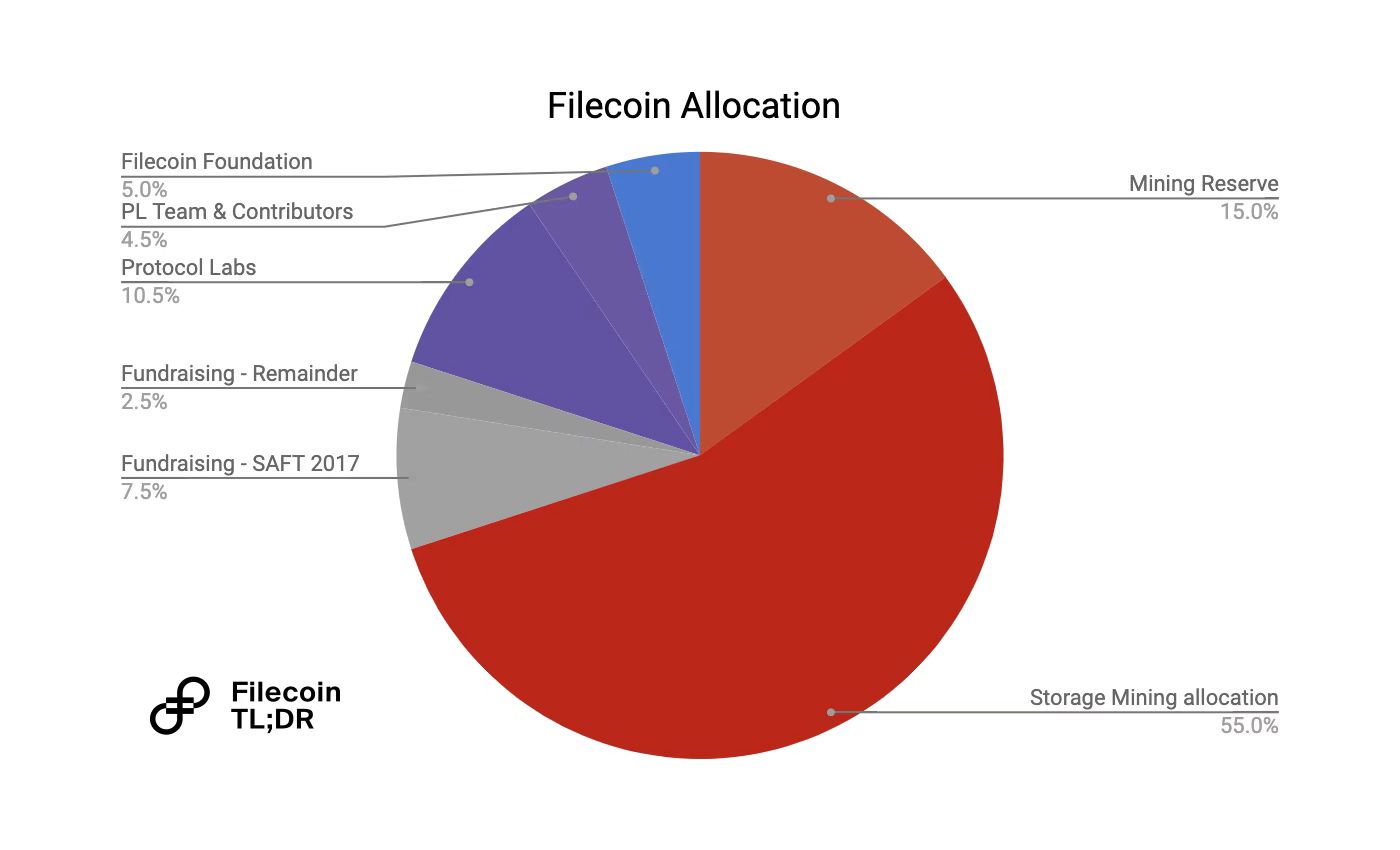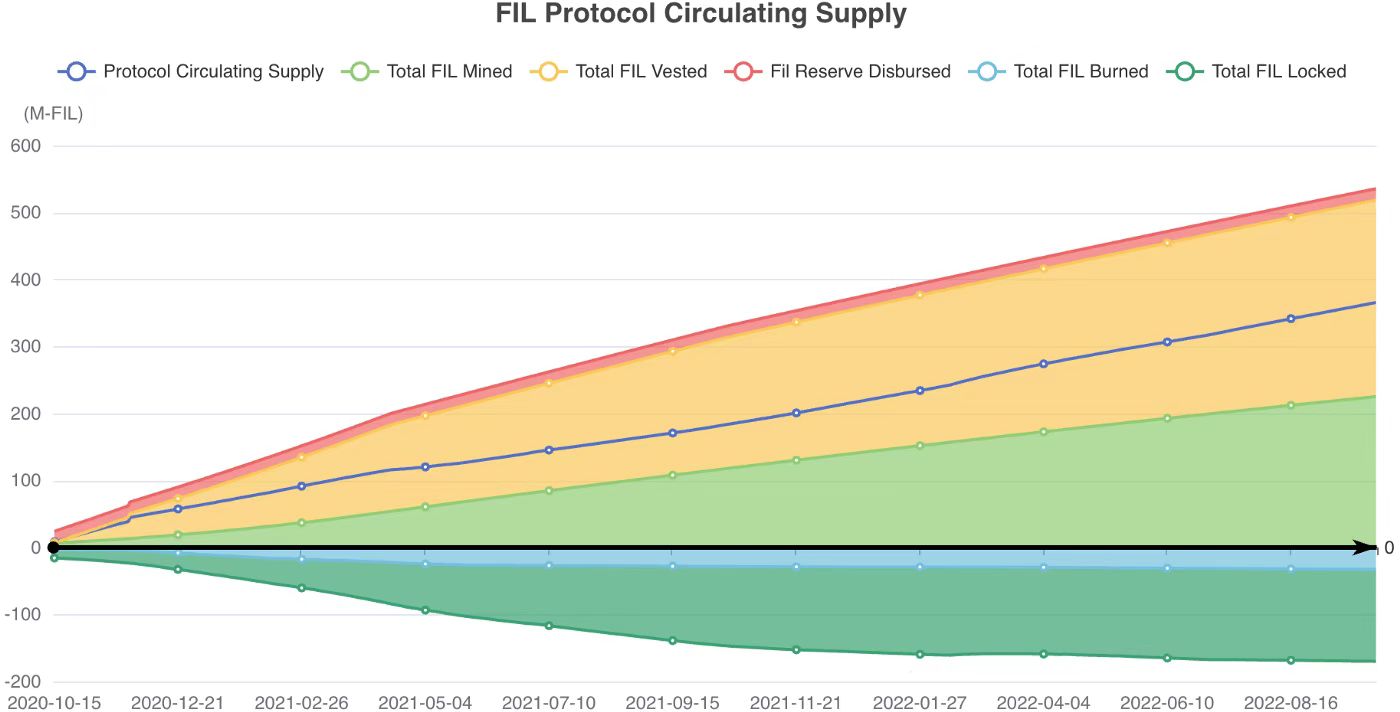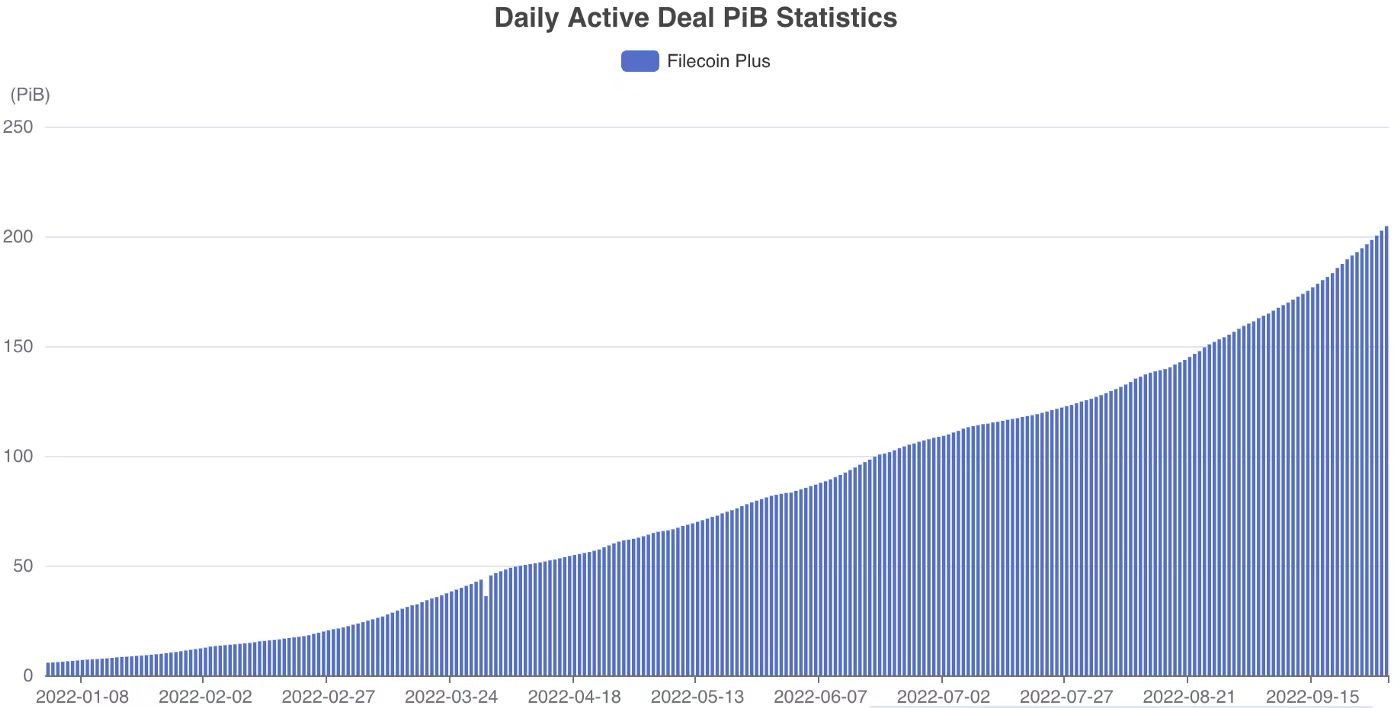FIL一路“高歌猛进”,其背后的代币经济有何隐藏信息?
本文来自 Medium,原文作者:Vik Kalghatgi,由 Odaily 星球日报译者 Katie 辜编译。

自分布式存储网络 Filecoin 于上周发布 2023 年三项重大项目更新(FVM、数据计算、检索市场)后,FIL 在过去的一周不断打破自己的“天花板”,FIL 最新价格已经突破 9 USDT, 24 小时涨幅达 21.35% 。接下来 Odaily 星球日报就带大家一起来了解 Filecoin 代币经济对代币持有者和未来生态的影响。
Filecoin 介绍
Filecoin 网络于 2020 年 10 月推出,为 IPFS 协议引入了激励层,并实现了数据的开放服务。如今,Filecoin 网络被大众所熟知主要是作为一种开放服务的存储。然而,早期的一篇总结网络方向的文章为 Filecoin 提出了更大的愿景,也包括“存储、分发和转换数据的基础设施”。
Filecoin 执行这一愿景的“主要计划”首先要积累大量的硬件资源(存储容量和计算能力)。这一点很重要,因为Web3 基础设施能够可靠地取代传统云储存(甚至不仅是与传统云储存竞争)的唯一途径是,它能够以超过当前产品的数量级和规模运行。虽然还没有 Web3 协议实现这一点,但目前已经取得了一定进展。
此外,为了推动对网络资源(容量、检索和计算能力)的长期需求,至关重要的是用有效的数据引导网络,并开发软件和工具,以便在数据之上实现计算和可组合服务。最终对这些服务的需求将成为 Filecoin 区块链之上强劲经济的基础。
Filecoin 的代币经济在设计时就考虑到了这一长期愿景,并有助于激励网络的快速增长和发展。到目前为止,该网络的承诺存储容量超过 16 EiB,生态系统的爆炸式发展推动了对网络资源的需求。这种增长和持续的成功归功于 Filecoin 社区的努力,这是一个由存储客户端、开发人员、存储提供商(SP)、生态系统合作伙伴和代币持有者组成的互联网络。
Filecoin 代币
这种全球数字经济还需要一种单一的有效货币来进行交易。由于 Filecoin 是一个免许可的市场,具有可加密验证的商品,因此设计限制只能通过本地实用代币 Filecoin。FIL 代币具有多种功能:
为链上的消息付费。
作为质押品。为长期可靠的数据存储创造经济激励,并确保区块链以及 Interplanetary Consensus(IPC:Consensus Lab 旗舰项目)生效后的子网或分片(shard)的安全。
通过燃烧以调节共享资源(区块空间)。
与其他存储网络不同,Filecoin 代币主要关注激励可靠的服务和促进链上经济。存储市场存在于链下,但包含存储加密证明的消息锚定在链上。最关键的是,这意味着代币可以在不对网络的各种服务(存储、检索、计算等)的用户造成过度压力的情况下增值,而由于利用率的提高(即对区块空间的需求),代币持有者仍然可以从 FIL 消耗中受益。
面向代币持有者的代币经济
Filecoin 的 Token 分配
Filecoin 的加密经济结构有助于确保参与者的价值增值与协议的长期效用保持一致。因此,Filecoin 在网络启动时的初始分配目的是支持一种激励可持续价值创造的协议。

来源:Filecoin Spec。
根据当前协议规范,最多将创建 20 亿 FIL。其中, 70% 分配给存储和相关服务(即铸造代币以奖励存储提供商), 20% (从 2020 年 10 月开始,在 6 年内授予)分配给 Protocol Labs 和 Filecoin 基金会,以支持网络开发、采用和生态系统增长。剩余的 FIL 分配给 SAFT 投资者,于 2020 年 10 月开始授予,期限从 6 个月到 3 年不等。
20 亿 FIL 是理论上可以铸造和授予的最大金额。然而,这可能不是最终进入网络循环供应的 FIL 的数量:
作为挖矿储备持有的 3 亿 FIL 需要进行协议升级才能被挖出,这意味着由社区决定应该释放多少数量。
网络的增长需要使用和消耗代币,从而减少了可用的代币供应。截至 2022 年 9 月底,已铸造或授予约 5.2 亿 FIL。其中,大约 70% 处于流通中,因为大量的 FIL 由于网络交易费用被烧毁(永久从流通中移除),或被锁定为质押品以确保网络安全并激励可靠的存储。随着网络的成熟,代币排放率(归属和铸造)预计会逐渐降低,因为 Filecoin 具有有限的归属时间表和一个排放与网络增长挂钩的铸造模型。
代币供应:净流入或流出
代币持有者了解决定代币供应的净流入或流出,将帮助其理解代币的相对购买力。

简单来说,铸造,归属,锁定和燃烧有助于流通供应中代币的净流入或流出。下面是自主网推出以来 Filecoin 代币供应的演变。

来源:Starboard Ventures。数据截至 2022 年 9 月 30 日。这张图表仅代表历史数据。由于 Filecoin 的流通供应受到市场输入的影响,因此无法准确预测。
目前,该网络正在扩大。Filecoin 基金会和 Protocol Labs 的代币归属支持生态系统的发展和增长,而存储提供商的区块奖励则奖励交易和存储容量的上线。这为代币持有者提供了一个参与生态系统增长的巨大机会,因为他们可以借钱给存储提供商(SP),促进存储提供商对 FIL 的需求,并分享由此产生的网络奖励。通过这种方式,代币持有者可以在支持网络增长和推进 Filecoin 愿景的同时,对代币排放进行检索。
Filecoin 生态系统路线图:对代币持有者的影响
在 Filecoin 生态系统中,在用户可编程性、数据登录性、数据可检索性、可扩展性和计算方面的持续改进将在未来 3 个季度实现。这些举措应该通过支持客户端需求、解锁各种网络用例,并最终推动代币的使用,对代币持有者产生积极影响。下面将讨论其中一些重要的改进及其潜在的经济影响。
Filecoin 虚拟机(FVM)
Filecoin 虚拟机解锁了无限的可能性,从可编程存储原始系统,到跨链互操作性桥,再到以数据为中心的去中心化自治组织 DAO 和 Layer 2 解决方案。简而言之,这意味着智能合约和用户可编程性将进入 Filecoin。预计于 2023 年上半年发布,这次网络升级应该会对代币持有者产生积极影响,因为它可能会增加 FIL 的用例,并可能会影响循环供应方程的“流出量”组成部分(FIL 锁定和烧毁)。
FVM 和代币供应中的流出部分
只要网络上存在操作或实用程序,FIL 代币将被消耗(烧毁),以补偿链消息消耗的计算和存储资源。引入智能合约功能可能会增加对区块空间的需求,从而导致燃烧的 FIL 增加。当网络参与者争夺链上资源时,该代币消耗率掌握在社区手中。
此外,FVM 协议升级可增加投入使用和/或锁定的 FIL 的量。目前,锁定在网络上的大部分 FIL 来自存储提供商质押品。FVM 引入了大量资金锁定以支持各种智能合约应用的可能性。DeFi协议只是应用程序的一个子集,它们可以利用 Filecoin 的有效工作证明链,不仅增加了代币消耗,还为锁定/锁定 FIL 生成了新的用例。
FVM 的独特之处在于它为 Filecoin 网络带来了新动力。虽然今天你可以与存储提供商签约来存储你的数据,但通过 FVM,可以添加额外的规则、自动化以及与其他服务(例如 DeFi)的可组合性。随着 Filecoin 路线图的其他组成部分(检索市场、数据计算等)的实现,我们希望 FVM 能够利用 Filecoin 的基本设施促进更复杂的产品的落地,从而促进更广泛的网络采用。
Filecoin Plus 和数据全域连接(Data Onboarding)
Filecoin Plus (FIL+)是一种实用的解决方案,目的是激励 Filecoin 网络的高效使用。由于很难从算法上区分真实有用的数据和生成的随机数据,FIL+在网络中引入了社会信任层。在 FIL+程序中,经过验证过程的客户端被授予一个新的资源 DataCap,他们可以使用该资源与存储提供商(SP)进行存储交易。SP 被激励与使用 DataCap 的客户签订存储协议,因为与常规(非 FIL+)交易相比,FIL+交易提高了他们获得的区块奖励数量,或通过向网络提交存储容量。为了从 FIL+获得这些额外的奖励,存储提供商提供了更多的质押品(大约是非 FIL+存储部门质押品的 10 倍),并在网络上锁定更多的代币。
到目前为止,我们看到来自 FIL+客户的数据强劲增长,这表明有效的全域连接数据(Data Onboarded:通过标签连接线下和线上的数据,如 B2B或 B2C数据集的匹配。)的数量正在增加。

来源:Starboard Ventures。数据截至 2022 年 9 月 30 日。
从代币经济的角度来看,这种趋势持续存在可能会增加网络上锁定的代币,并减少流通的代币供应。更重要的是,随着 Filecoin 网络朝着存储有效数据的使命发展,代币的消耗和利用率也会增长。
Interplanetary Consensus 升级(IPC:ConsensusLab 旗舰项目)
IPC 是即将到来的网络升级,目的是增加 Filecoin 可以支持的用例,同时提高网络的可扩展性、吞吐量和最终性,是一个令人兴奋的区块链创新。通过子网(分片)横向扩展链,IPC 也对加密经济有潜在的影响,并可能增加:
由于可扩展性的提高以及 FVM 利用率,FIL 的燃烧量也降低了用户的 Gas 费用。
为确保子网安全而锁定(或质押)作为质押品的 FIL 数量。
支持定制链上用例的分片的 FIL 消耗需求。
总结
作为一种新型的数据存储和应用网络,Filecoin 的使命是为社会信息创建一个去中心化、高效、稳健的基础。Filecoin 生态系统中支持这一任务的开发数量众多,将对代币持有者产生积极影响。该协议的代币经济的目的是奖励长期参与和对网络的贡献。社区参与者可以通过了解代币经济,特别是代币流入和流出的来源而提高收益,这些来源支撑着代币经济。展望未来,协议的持续改进可能会为网络和代币带来新的令人兴奋的使用案例,有可能进一步推动代币持有者的参与,并积极推动这一快速增长的生态系统的价值主张。
免责声明:此个人观点仅供参考,非投资建议,DYOR。



